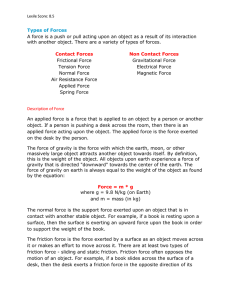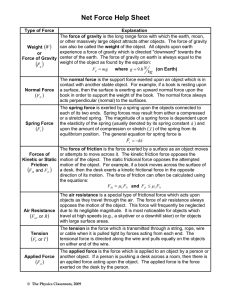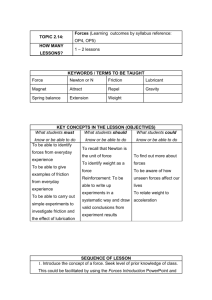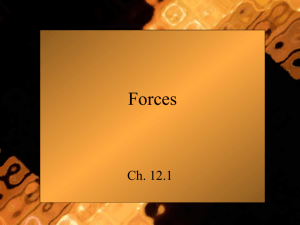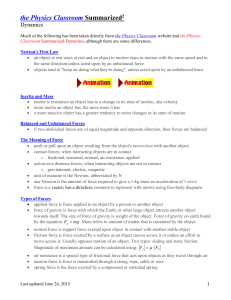Notes from The Physics Classroom (designed for high school
advertisement
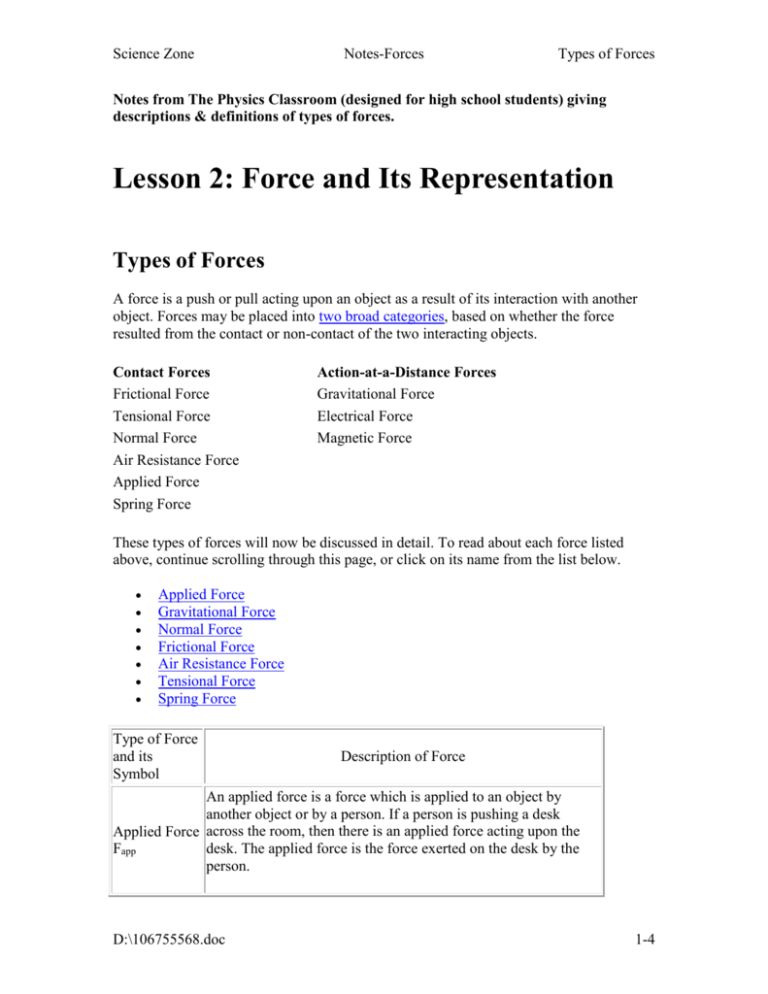
Science Zone Notes-Forces Types of Forces Notes from The Physics Classroom (designed for high school students) giving descriptions & definitions of types of forces. Lesson 2: Force and Its Representation Types of Forces A force is a push or pull acting upon an object as a result of its interaction with another object. Forces may be placed into two broad categories, based on whether the force resulted from the contact or non-contact of the two interacting objects. Contact Forces Frictional Force Tensional Force Normal Force Air Resistance Force Applied Force Spring Force Action-at-a-Distance Forces Gravitational Force Electrical Force Magnetic Force These types of forces will now be discussed in detail. To read about each force listed above, continue scrolling through this page, or click on its name from the list below. Applied Force Gravitational Force Normal Force Frictional Force Air Resistance Force Tensional Force Spring Force Type of Force and its Symbol Description of Force An applied force is a force which is applied to an object by another object or by a person. If a person is pushing a desk Applied Force across the room, then there is an applied force acting upon the desk. The applied force is the force exerted on the desk by the Fapp person. D:\106755568.doc 1-4 Science Zone Notes-Forces Types of Forces Return to Top The force of gravity is the force with which the earth, moon, or other massive body attracts an object towards itself. By definition, this is the weight of the object. All objects upon earth experience a force of gravity which is directed "downward" towards the center of the earth. The force of gravity on an object on earth is always equal to the weight of the object as given by Gravity Force the equation: (also known Fgrav = m * g where: g = acceleration of gravity = 9.8 m/s2 (on as Weight) Earth) Fgrav m = mass (in kg) (Caution: do not confuse weight with mass.) Return to Top The normal force is the support force exerted upon an object which is in contact with another stable object. For example, if a book is resting upon a surface, then the surface is exerting an Normal Force upward force upon the book in order to support the weight of the book. On occasion, a normal force is exerted horizontally Fnorm between two objects which are in contact with each other. Return to Top The friction force is the force exerted by a surface as an object moves across it or makes an effort to move across it. The friction force opposes the motion of the object. For example, if a book moves across the surface of a desk, the desk exerts a friction force in the direction opposite to the motion of the book. Friction results when two surfaces are pressed together closely, causing attractive intermolecular forces between the molecules Friction Force of the two different surfaces. As such, friction depends upon the Ffrict nature of the two surfaces and upon the degree to which they are pressed together. The friction force can be calculated using the equation: Return to Top Air Resistance Force Fair Air resistance is a special type of frictional force which acts upon objects as they travel through the air. Like all frictional forces, the force of air resistance always opposes the motion of D:\106755568.doc 2-4 Science Zone Notes-Forces Types of Forces the object. This force will frequently be ignored due to its negligible magnitude. It is most noticeable for objects which travel at high speeds (e.g., a skydiver or a downhill skier) or for objects with large surface areas. Return to Top Tensional Force Ftens Tension is the force which is transmitted through a string, rope, or wire when it is pulled tight by forces acting at each end. The tensional force is directed along the wire and pulls equally on the objects on either end of the wire. Return to Top Spring Force Fspring The spring force is the force exerted by a compressed or stretched spring upon any object which is attached to it. This force acts to restores the object, which compresses or stretches a spring, to its rest or equilibrium position. For most springs (specifically, for those said to obey "Hooke's Law"), the magnitude of the force is directly proportional to the amount of stretch or compression. Return to Top Mass vs. Weight The force of gravity is a source of much confusion to many students of physics. The mass of an object refers to the amount of matter that is contained by the object; the weight of an object is the force of gravity acting upon that object. Mass is related to "how much stuff is there" and weight is related to the pull of the Earth (or any other planet) upon that stuff. The mass of an object (measured in kg) will be the same no matter where in the universe that object is located. Mass is never altered by location, the pull of gravity, speed or even the existence of other forces. For example, a 2-kg object will have a mass of 2 kg whether it is located on Earth, on the moon, or on Jupiter; its mass will be 2 kg whether it is moving or not (at least for purposes of this study); and its mass will be 2 kg whether it is being pushed or not. On the other hand, the weight of an object (measured in Newtons) will vary according to where in the universe the object is. Weight depends upon which planet is exerting the force and the distance the object is from the planet. Weight, being equivalent to the force of gravity, is dependent upon the value of g (acceleration of gravity). On Earth's surface, g is 9.8 m/s2 (often approximated to 10 m/s2). On the moon's surface, g is 1.7 m/s2. Go to another planet, and there will be another g value. In addition, the g value is inversely D:\106755568.doc 3-4 Science Zone Notes-Forces Types of Forces proportional to the distance from the center of the planet. So if g were measured at a distance of 400 km above the earth's surface, you would find the value of g to be less than 9.8 m/s2. (The nature of the force of gravity will be discussed in detail in Unit 6 of The Physics Classroom.) Always be cautious of the distinction between mass and weight. It is the source of much confusion for many students of physics. You must thoroughly understand the meaning of each of these forces if you are to successfully proceed through this unit. Ultimately, you must be capable of reading the description of a physical situation and knowing enough about these forces to recognize their presence (or absence) and to construct a free-body diagram which illustrates their relative magnitudes and directions. Here are a few sample problems to get you started. Consider also the Free Body Diagrams interactive exercise at the Shockwave Physics Studios. D:\106755568.doc 4-4
